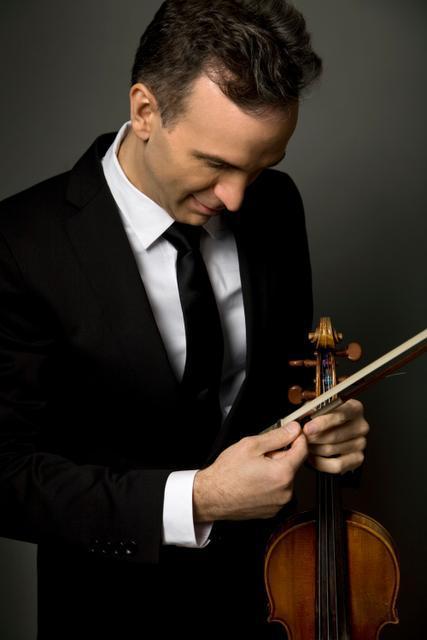Shaham’s noble, electric Brahms lights up New World concert at Arsht

Gil Shaham performed Brahms’ Violin Concerto with Michael Tilson Thomas and the New World Symphony Saturday night at the Arsht Center.
The audience at the Arsht Center braced itself for the music of Alban Berg, whose early 20th century modernism still baffles many listeners.
“It’s courageous of you to listen to it,” said Michael Tilson Thomas, music director of the New World Symphony, in a talk before the performance. “We really appreciate it.”
Whenever New World crosses Biscayne Bay to perform at the big Miami concert hall, the orchestra brings a big-name soloist with a crowd-pleasing repertory staple, in this case, Gil Shaham and the Brahms Violin Concerto. But the concert Saturday also included a not particularly crowd-pleasing work, Berg’s Three Pieces for Orchestra, whose 12-tone harmonic vocabulary remains a high obstacle to its appreciation even today.
Berg has always been considered the most approachable of twelve-tone composers. Critics have long detected the influence of the recently deceased Gustav Mahler on the Three Pieces for Orchestra, a musical debt that’s apparent throughout in the reedy trumpets, languorous strings, aggressive percussion and Mahlerian turns of phrase. But then there’s the harmony.
“Had Mahler gone on to write an 11th, 12th and 13th symphony and then decided to perform two of them simultaneously, that might be like what you’re about to hear,” Tilson Thomas said.
The orchestra’s performance turned to be an evocative expression of Berg’s moonlit world, with its eerie wind playing, whirlpools of strings and abrupt bursts of violence from brass and percussion. Under Tilson Thomas’s direction, the Prelude moved forward with theatrical flair, its fragments of phrases joining to create long, intelligible phrases. The orchestra’s playing was tight and precise, but full of the swirling fog and mist that characterizes the music.
The Round Dance music came off as dreamlike, until the brass came in with shattering force. The concluding March was particularly reminiscent of Mahler, with its rattling snare drum and the use of hammer blows in the percussion. Aching, tentative ascending lines of melody resolved into march music of clicking precision and swaggering menace, with the percussion providing the extra bit of violence.
There was hearty applause as the work ended with a few people standing. But there was a lot more applause and cheers following the next work, the Brahms Violin Concerto.
In the Brahms concerto, one of the most difficult works in the repertory, Shaham’s playing was accurate and seemingly effortless, as his rock-steady bow arm and perfect intonation seemed to easily handle Brahms’ knotty violin writing. Beyond that, he brought an edgy excitement to the performance, with his big, intense sound cutting through the massed forces of the orchestra.
In the first movement, there is a recurring series of ascending chords in the violin. Shaham played with crisp authority and crunchy power in this music that audibly strains the violin’s capabilities, adding to the music’s impact.
The entrance of the orchestra after a cadenza has produced some of the greatest moments in the violin concerto literature, for example in the concertos of Beethoven and Mendelssohn, and the second movement of Mozart’s Sinfonia Concertante. The Brahms concerto takes a place on this list, as the violinist’s showing-off period leads to the return of the main theme, and Shaham and the orchestra did it justice, with the soloist’s golden tone soaring over the richly colored harmonies in the orchestra.
Under Tilson Thomas, the orchestra performed in a clean and accurate manner. But the ensemble didn’t match Shaham for intensity and played in a manner that seemed subdued at times for music that’s so full of symphonic grandeur.
The orchestral literature is full of great oboe solos, and one of these is the long melody that opens the Adagio, which routinely appears on the required repertory lists for orchestral oboe auditions. Oboist Joo Bin Yi gave a luminous performance, playing with a rich but focused tone, taking his time and phrasing the melody with eloquence.
Shaham’s playing was most striking in the dark, minor-key outburst that begins in the instrument’s upper range, with the soloist’s playing getting more and more impassioned. Even high on the violin’s top string, where some soloists’ notes turn wispy and warbly, he maintained a rich and noble tone.
It’s always pleasant to see a soloist enjoying a performance, and that quality came through throughout Shaham’s time on stage – for example in his glance toward Tilson Thomas, with a smile of anticipation, his bow raised, as he prepared to pounce on the opening notes of the Gypsy-flavored last movement. Here his rock-solid intonation brought off the doubled and tripled notes with accuracy and clanging authority, with an electric excitement that kept the momentum going to the end.
As an encore, Shaham and the orchestra performed Schön Rosmarin by the Austrian violinist and composer Fritz Kreisler, a salon work that showed off the chic, elegant side of Shaham’s playing.
The concert opened with Schumann’s Overture to The Bride of Messina, led by New World conducting fellow Chad Goodman. This rarely played overture must be one of Schumann’s darkest and most turbulent concert works.
Under Goodman’s direction, the orchestra played in a taut, disciplined manner in the gruff music, reminiscent of a Beethoven overture in its clipped intensity. The music, with violins carrying most of the melodic load, lurched forward with a feeling of accelerating drama. Even the tranquil middle passages in winds, with clarinet particularly prominent, had a feverish tone, as if the return of the storm wasn’t far off.
Posted in Performances
One Response to “Shaham’s noble, electric Brahms lights up New World concert at Arsht”
Leave a Comment
Sun Oct 27, 2019
at 12:31 pm
1 Comment







Posted Oct 27, 2019 at 1:44 pm by rosa abraira
excellent comments
Mahler much more melodious and pleasant to my ear than Alban Berg